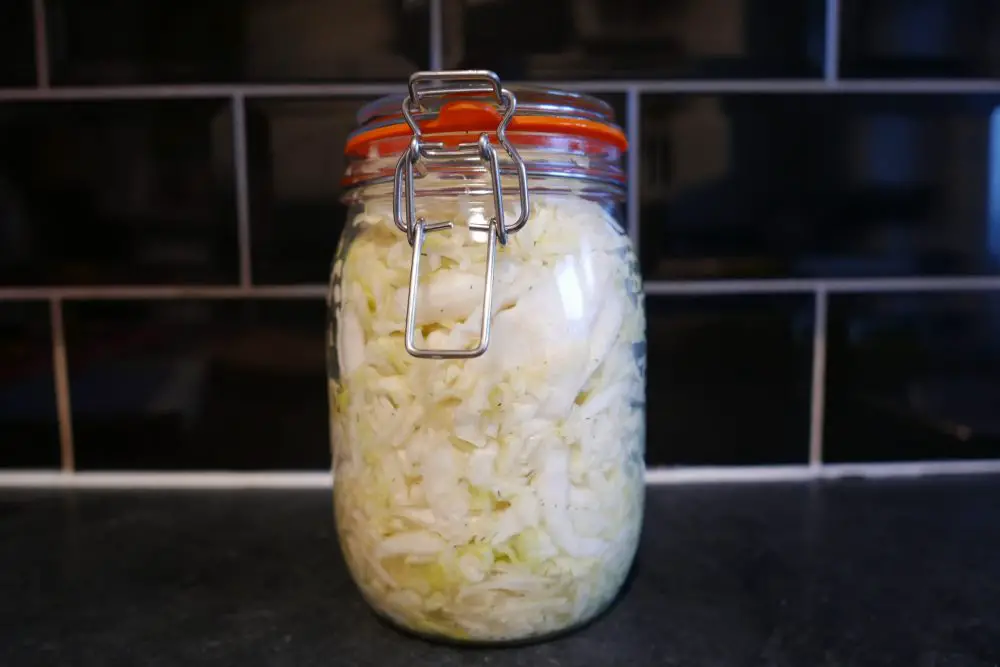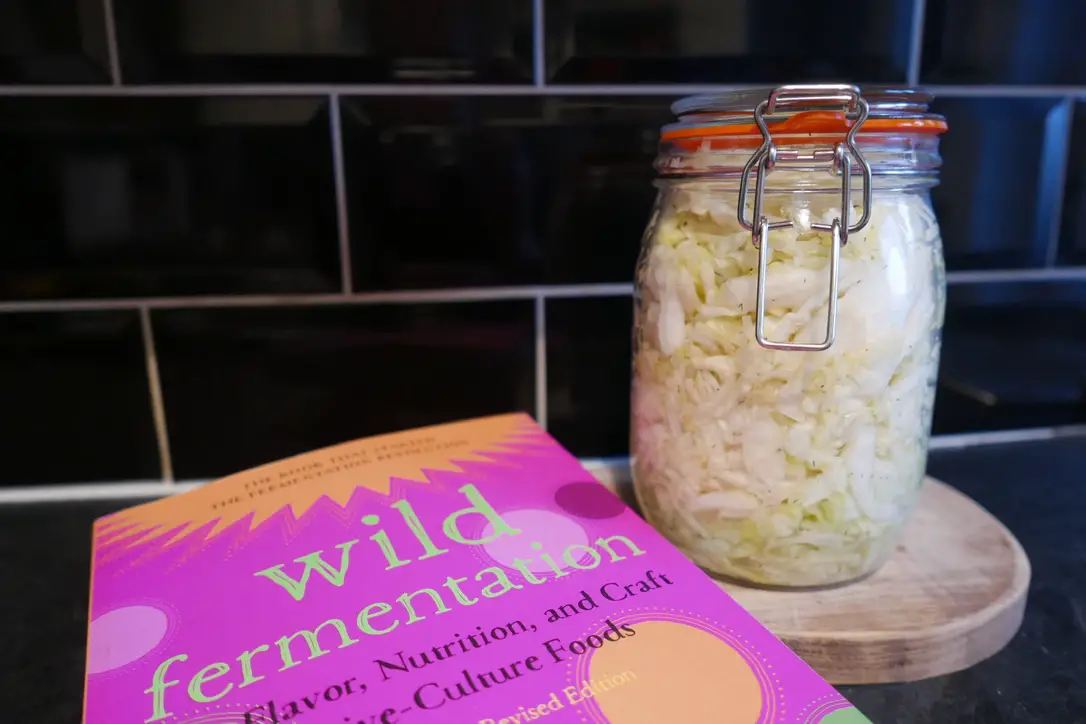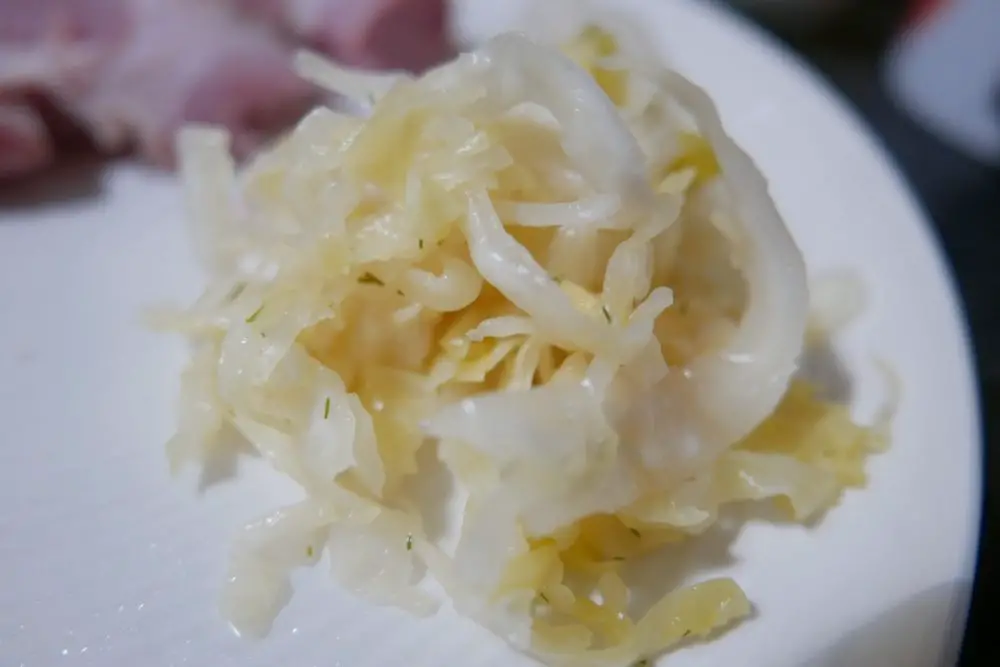
Quick recap
Cooking the books is something I came up with to try and make better use of my huge collection of cookbooks. The concept is simple – every month I ask my social media followers to vote for one of three books from my collection. I write a review of the chosen book and select a something at random to make. The winner was this easy sauerkraut recipe from Wild Fermentationby Sandor Katz. I actually met Sandor in 2019 at Abergavenny Food Festival and he appeared as a guest on my food podcast. So, after reading this post, if you want to know more, I’d suggest giving that episode a listen!

Caveat – during lockdown I’m choosing the recipe not by random but by what I either already have in or can easily get hold of!
Wild Fermentation by Sandor Katz
This is less of a cookbook and more of a manual / deep dive into fermentation. It’s a book you can sit down and read or dip in and out of for advice, recipes and tips. The amount of information in it is staggering.
As well as a lot of background around the history, theory and benefits of fermented foods, Sandor includes chapters on all sorts of ferments – with plenty of recipes. And not just those you’d expect but unusual stuff including drinks, grains, wine and even dairy. This book is dense with info and whatever you’re trying to do, I’m sure it’s covered. One thing which is super handy is that for all of Sandor’s recipes, he offers variations and advice on what could go wrong so you feel as though you’re being coached along the way. I found that really useful when making this easy sauerkraut recipe. Fermentation is a big topic and there’s a lot to learn so this is a book you’ll keep coming back to.
According to wikipedia:
Fermentation in food processing is the process of converting carbohydrates to alcohol or organic acids using microorganisms—yeasts or bacteria—under anaerobic conditions. Fermentation usually implies that the action of microorganisms is desired. The science of fermentation is known as zymology.
But of course it’s so much more than that. Its kitchen alchemy – taking just a few ingredients and letting nature take its course. It seems scary at first – leaving cabbage and spices to essentially ‘go off’ and then tentatively eating them to find the mixture has turned into delicious kimchi for example. Or, in the easy sauerkraut recipe below, cabbage, salt and dill. This is something that people have been doing for thousands of years though, and actually it’s very good for your gut. Sandor refers to himself as a ‘fermentation revivalist’ – bringing this age old practice into the everyday Western kitchen. I applaud him for that and if you get chance to see him speak (on or offline) I recommend it. He’s full of life and so engaging! If you don’t have this book, it’s a must have for serious cooks. And that brings me nicely onto his easy sauerkraut recipe…

Easy sauerkraut recipe
Recipe copied from the Wild Fermentation website and converted to UK measurements for a 1 litre jar.
Timeframe: 3 days to 3 months (and beyond)
Vessel: 1 litre jar with wide mouth.
Ingredients :
- 1kg of vegetables (cabbage alone or at least half cabbage and the remainder any combination of radishes, turnips, carrots, beets, kohlrabi, Jerusalem artichokes, onions, shallots, leeks, garlic, greens, peppers, or other vegetables)
- 1 tbsp salt (start with a little less, add if needed after tasting) I went with white cabbage only for my first try!
Other seasonings as desired, such as caraway seeds, juniper berries, dill, chili peppers, ginger, turmeric, dried cranberries, or whatever you can conjure in your imagination. I used just dill.

Process:
- Prepare the vegetables. Remove the outer leaves of the cabbage and reserve. Scrub the root vegetables but do not peel. Chop or grate all vegetables into a bowl. The purpose of this is to expose surface area in order to pull water out of the vegetables, so that they can be submerged under their own juices. The finer the veggies are shredded, the easier it is to get juices out, but fineness or coarseness can vary with excellent results.
- Salt and season. Salt the vegetables lightly and add seasonings as you chop. Sauerkraut does not require heavy salting. Taste after the next step and add more salt or seasonings, if desired. It is always easier to add salt than to remove it. (If you must, cover the veggies with dechlorinated water, let this sit for 5 minutes, then pour off the excess water.)
- Squeeze the salted vegetables with your hands for a few minutes (or pound with a blunt tool). This bruises the vegetables, breaking down cell walls and enabling them to release their juices. Squeeze until you can pick up a handful and when you squeeze, juice releases (as from a wet sponge).
- Pack the salted and squeezed vegetables into your jar. Press the vegetables down with force, using your fingers or a blunt tool, so that air pockets are expelled and juice rises up and over the vegetables. Fill the jar not quite all the way to the top, leaving a little space for expansion. The vegetables have a tendency to float to the top of the brine, so it’s best to keep them pressed down, using one of the cabbage outer leaves, folded to fit inside the jar, or a carved chunk of a root vegetable, or a small glass or ceramic insert. Screw the top on the jar; lactic acid bacteria are anaerobic and do not need oxygen (though they can function in the presence of oxygen). However, be aware that fermentation produces carbon dioxide, so pressure will build up in the jar and needs to be released daily, especially the first few days when fermentation will be most vigorous.
- Wait. Be sure to loosen the top to relieve pressure each day for the first few days. The rate of fermentation will be faster in a warm environment, slower in a cool one. Some people prefer their krauts lightly fermented for just a few days. Others prefer a stronger, more acidic flavor that develops over weeks or months. Taste after just a few days, then a few days later, and at regular intervals to discover what you prefer. Along with the flavour, the texture changes over time, beginning crunchy and gradually softening. Move to the refrigerator if you wish to stop (or rather slow) the fermentation. In a cool environment, kraut can continue fermenting slowly for months. In the summer or in a heated room, its life cycle is more rapid; eventually it can become soft and mushy.
- Surface growth. The most common problem that people encounter in fermenting vegetables is surface growth of yeasts and/or molds, facilitated by oxygen. Many books refer to this as “scum,” but I prefer to think of it as a bloom. It’s a surface phenomenon, a result of contact with the air. If you should encounter surface growth, remove as much of it as you can, along with any discolored or soft kraut from the top layer, and discard. The fermented vegetables beneath will generally look, smell, and taste fine. The surface growth can break up as you remove it, making it impossible to remove all of it. Don’t worry.
- Enjoy your kraut! I start eating it when the kraut is young and enjoy its evolving flavor over the course of a few weeks (or months in a large batch). Be sure to try the sauerkraut juice that will be left after the kraut is eaten. Sauerkraut juice packs a strong flavor, and is unparalleled as a digestive tonic or hangover cure.
- Develop a rhythm. Start a new batch before the previous one runs out. Get a few different flavors or styles going at once for variety. Experiment!
I made this easy sauerkraut recipe just before Christmas. Within a week it was delicious, but after about two it was especially good. The top part of the cabbage wasn’t great so I dug down to pull out from the bottom of the jar. Will definitely make this again and am pleased to have added something to my fermentation repertoire which currently includes kimchi, sourdough and kombucha. Next step, something braver!

